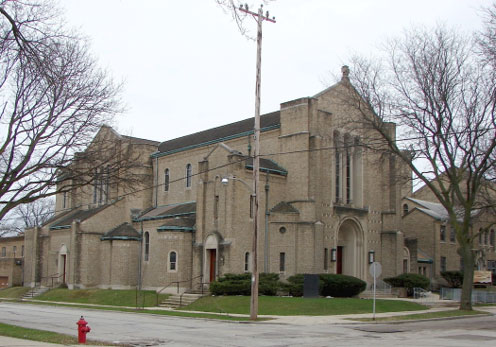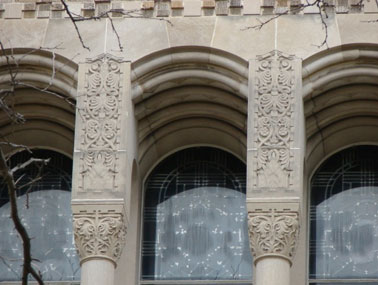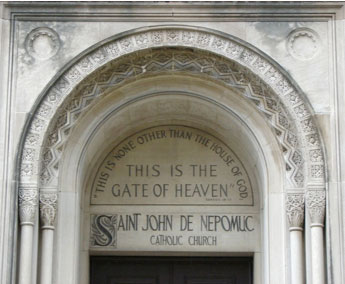24. St. John de Nepomuc Catholic, 1942
Now Pilgrim Rest Missionary Baptist
3456 North 38th Street (at Keefe Avenue)
Architect: Henry Slaby
In 1870, there were about 1,800 Czech immigrants and descendants of Czech immigrants in Milwaukee. They were referred to as Bohemians at that time, as Czechoslovakia was not established until the conclusion of World War I. Bohemia, comprising most of what is now the Czech Republic, was at one time a separate kingdom and in the nineteenth and early twentieth centuries was a province within the Austrian Empire. From the time of its establishment in the late 1860s, St. John de Nepomuc Parish served Milwaukee’s Czech immigrants and a smaller number of other Slavic-language immigrants. The first church, acquired by the parish from a German Protestant congregation in 1867, was located at 4th and Cherry Streets.
As the city’s Czech population grew over the following decades, the parish eventually needed a larger church and acquired the property at 38th Street and Keefe Avenue in 1926. This was more than three miles northwest of the old church, in an area that had been annexed by the City of Milwaukee only two years earlier and was at that time on the outer edge of urban development. More German and Irish Catholics joined the parish at this new location, but the Czech population continued to make up the largest portion of the membership. The parish first built a combined church and school on the property, with plans to build a separate church within a few years. However, the depression of the 1930s caused the parish to delay construction of the new church for a much longer period than anticipated.
When the time finally came to build a new church, the parish turned to one of its own members, the architect Henry R. Slaby (1906-1995). Slaby’s parents were Czech immigrants who left Prague and settled in Milwaukee about 1890. Slaby apprenticed with the Milwaukee firm of Herbst and Kuenzli and later worked for the Works Progress Administration before establishing his own office in 1937. St. John de Nepomuc was his first church commission. He later designed several other Catholic churches in Milwaukee and its suburbs, including St. Stephen Martyr, built in 1969. Slaby also designed schools, hospitals, and other buildings for the Catholic Church.
St. John de Nepomuc is the last of the Romanesque Revival churches in Milwaukee. Although some architects continued to design Gothic Revival churches into the late 1950s, and the Colonial Revival continued even later, no Romanesque Revival churches have been constructed in the city since World War II. With St. John de Nepomuc, the style at least went out with a bang rather than a whimper.
The church has a basilican plan with a tall, narrow nave. It is smaller than most churches of the Romanesque period but more in keeping with their proportions. The windows are relatively small and widely spaced, giving the building a more solid and massive appearance. Overall, St. John de Nepomuc is representative of the more academic phase of the historical revival styles that architects developed beginning in the early twentieth century. This phase of revivalist architecture was in part a consequence of new scholarship on historic buildings, including those of medieval Europe. Architects had access to more written and photographic documentation on earlier buildings, and in some cases drawings based on precise measurements. Although this scholarly approach to design is more often seen in the Gothic Revival, St. John de Nepomuc is an excellent example in the Romanesque Revival style.
St. John de Nepomuc Parish ceased operations in 1998, with the members going to nearby parishes such as St. Martin de Porres (formerly St. Elizabeth) and All Saints (formerly St. Agnes). The Catholic Church retained ownership of the building for use as a chapel until 2015, when it was sold to Pilgrim Rest Missionary Baptist Church. Pilgrim Rest Baptist was formerly located just seven blocks to the northwest, at Sherman Boulevard and Roosevelt Drive.
Sources:
Acker, Daniel. The Czech Community of Milwaukee: 1848-1998. C. 2001.
Hlavac, Alexander E. “History of St. John de Nepomuc Parish: Milwaukee, Wisconsin, 1863-1942.” M. A. Thesis, St. Francis Seminary, 1942.
Knoche, Eldon. “Architect Slaby was Designer of Churches,” Milwaukee Journal-Sentinel, November 25, 1995, page 6B, column 5.



